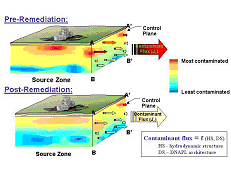| |
|
Nonaqueous-Phase Liquid Zones
NAPLs are liquids with a density less than water. They are hydrocarbons that can affect groundwater quality. Understanding their fate and transport in groundwater and the remediation technologies for NAPL recovery are important areas of study for EPA.
|
|
Introduction
The remediation of subsurface formations contaminated by nonaqueous-phase liquids (NAPLs) is a major impediment to the restoration of many hazardous waste sites. NAPLs are classified as liquids lighter than water (LNAPL) or denser than water (DNAPL) and can serve as long-term sources of contamination impacting both groundwater and surface water. Conventional remediation techniques designed for dissolved contaminant removal have proven inadequate for achieving acceptable environmental cleanup goals within reasonable time frames for NAPL-contaminated source zones.
Field-scale research has demonstrated that a high percentage of NAPL mass can be rapidly depleted within source zones by using aggressive in situ thermal or chemical flushing technologies. Even with these aggressive technologies, the efficiency of NAPL depletion often decays exponentially with increasing mass removed and complete NAPL removal may not be technically or economically feasible. For such sites, the key questions are:
- How much NAPL must be removed to be protective of human health and the environment?
- Are current technologies adequate to achieve this level of removal?
To answer these questions, we must understand the relationships between NAPL mass depletion, contaminant mass flux from the source zone, and dissolved plume properties EPA research is focused on three critical aspects:
GWERD research is focused on three critical aspects:
- Demonstration, evaluation, and optimization of NAPL remediation technologies
- Assessment and prediction of the benefits of partial NAPL depletion
- Development and assessment of integrated NAPL source remediation approaches
EPA conducts applied and fundamental research to further develop source zone remediation technologies and to understand the relationship between source zone mass removal and risk reduction.
References and Products
Ford, R.G., R.T. Wilkin, K.G. Scheckel, et al. Field Study of the Fate of Arsenic, Lead, and Zinc at the Ground Water/Surface Water Interface (EPA/600/R-05/161) December 2005 - Abstract
Mayer, P.M., S.K. Reynolds, T.J. Canfield, and M.D. McCutchen. Riparian Buffer Width, Vegetative Cover, and Nitrogen Removal Effectiveness: A Review of Current Science and Regulations (EPA/600/R-05/118) October 2005 - Abstract
Ford, R.G. The Impact of Ground Water-Surface Water Interactions on Contaminant Transport With Application to an Arsenic-Contaminated Site – Environmental Research Brief (22 pp, 2.58 MB) (EPA/600/S-05/002) January 2005 - Abstract
Mayer, P.M., E. Striz, R. Shedlock, E. Dohney, and P. Groffman. (2003). “The Effects of Ecosystem Restoration on Nitrogen Processing in an Urban Mid Atlantic Piedmont Stream (PDF).” (6 pp, 136 KB) In: Proceedings U.S. Department of Agriculture, Agricultural Research Service First Interagency Conference on Research in the Watersheds, Benson, Arizona, October 27–30. pp. 536–541.
Water Quality and Hydrology in the Hyporheic Zone and Floodplain of a Degraded Urban Stream (PDF) (2 pp, 287 KB) Contact: Paul Mayer
Ground Water and Surface Water Interactions Along Riparian Corridors in the Great Basin (PDF) (2 pp, 148 KB) Contact: David Jewett
The Fate of Arsenic During Discharge of Contaminated Ground Water Into a Surface Water Impoundment (PDF) (2 pp, 120 KB) Contact: Robert Ford
You will need Adobe Reader to view some of the files on this page.
See EPA's PDF page to learn more. |
![[logo] US EPA](../gif/logo_epaseal.gif)
